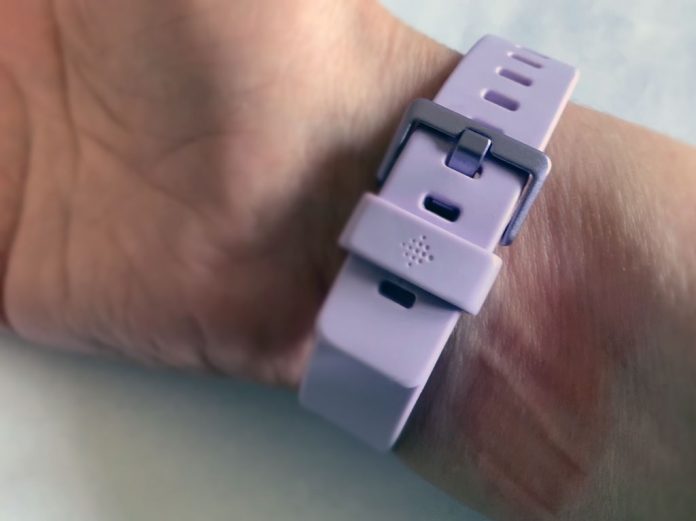
Can your Fitbit cause skin irritation or rashes? Unfortunately, yes. Learn what I did to prevent my Fitbit from causing my skin to react.
As much as I love my Fitbit Inspire, I don’t like the rashes and skin irritations that the Fitbit band often causes.
After struggling with this issue, I’ve learned a lot about how to keep your arms rash and irritation-free while still using your Fitbit every day (and every night for those that want sleep tracking.)
So here’s what I discovered!
Contents
- 1 Quick checklist
- 2 Why is my Fitbit causing skin irritation or rashes?
- 3 How do I prevent my Fitbit from causing redness, rashes, and other skin irritations?
- 4 How tight are you wearing your Fitbit?
- 5 Are you sweating a lot when working out or engaged in an activity?
- 6 Are you swimming or showering with it?
- 7 Are you routinely cleaning your Fitbit band and device?
- 8 Do you have a metal or materials allergy?
- 9 When all else fails, return it!
Quick checklist

Try these quick remedies to prevent your Fitbit from irritating your skin
- Wear your Fitbit loose so you can move it back and forth easily (but not up and down–that’s too loose!)
- Periodically take your Fitbit off to let your skin breathe. Remove your band for at least twenty minutes daily to allow your skin to be unencumbered.
- Switch your Fitbit from one arm to the other at night or in the morning, so you never have it on an arm for more than 24 hours.
- Thoroughly clean and dry your Fitbit and your arm after sweating to remove any trapped bacteria.
- Try using a barrier cream moisturizer on your arm. These creams form a physical barrier between your skin and any irritants and help to protect your skin against excess moisture caused by sweat etc. Look for moisturizers and barrier creams that include lipids, glycerine, and ceramides.
- If you suspect that you are allergic to the wristband materials, usually silicone, try using a fabric, woven, or leather band instead.
Related reading
- Turn your smartwatch into a biochemical monitoring system with special adhesive
- Need to restart or reset your Fitbit device? Learn the steps
- Does Fitbit, Garmin, or other wearable devices offer a Pulse Oximeter?
Why is my Fitbit causing skin irritation or rashes?
For most of us that get some skin reaction, our Fitbits (particularly the bands) are causing irritant contact dermatitis (eczema.)
When our Fitbits trap things like soap and sweat, and then we put pressure or add some friction to the mix, our skin reacts immediately, causing redness and then inflammation.
Some of us are actually allergic to some materials (usually metals like nickel) in the Fitbit itself.
When someone is allergic to those materials, their immune system responds to what’s called allergic contact dermatitis.
An allergic response usually takes longer (several days) to develop than a simple contact dermatitis response.
You may notice the following on the skin where you wear your Fitbit
- Redness
- Swelling
- A burning feeling
- Bumps
- Blisters
- Rashes
- Skin that appears scaly
How do I prevent my Fitbit from causing redness, rashes, and other skin irritations?
Okay, first, let’s ask ourselves some questions. Often, just changing one behavior can make a world of difference to your skin’s health.
How tight are you wearing your Fitbit?
You’re more likely to get skin irritation if the band is too tight–so keep it comfortably loose.
The rule of thumb with Fitbits is to wear them a bit loose–usually looser than you think they should be.
The preferred placement for your Fitbit is about two to three full-finger distances from your wrist. The best measure for this is your fingers.
Although Fitbit suggests placing your Fitbit band a finger’s width above your wristbone when not exercising, we find that placing it 2-3 fingers distance works best!

- Put your index, middle, and ring fingers together so they touch each other.
- Place those two or three fingers just below your wrist on the arm that you intend to wear your Fitbit.
- It’s a good idea to repeat on your other arm, so you know the placement on both arms for when you might switch arms.
- Place the Fitbit band at that location on your arm.
- Buckle the Fitbit band one notch looser so it’s snug but not tight.
- The perfect fit is when your device comfortably stays in place and does not slide up and down your wrist.
- You should be able to stick one or two fingers between the band and your skin easily without resistance.
We recommend the three-finger arms placement since this is the best way to track your heart rate. We often bend our wrists frequently during the day (at work, exercise, or play.) Frequent wrist bending interferes with Fitbit’s heart-rate sensor.
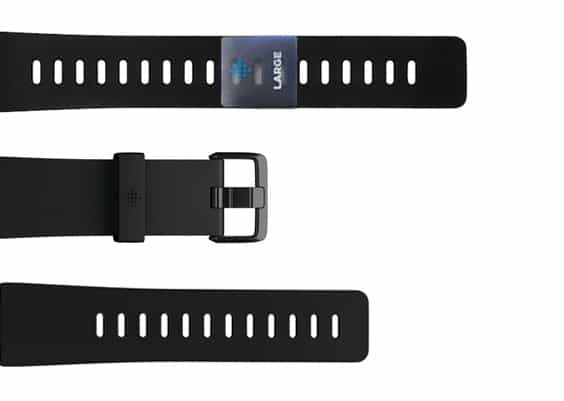
If you cannot get your Fitbit comfortably loose, try changing your Fitbit’s band and use the longer band that came with your device if you aren’t currently using it. And if needed, purchase an extender band or a third-party band that fits your arm.
Do you have hairy arms?
If you usually wear your Fitbit tight due to your arm hair, we suggest you instead follow the steps above for a loose, comfortable fit BUT wear your Fitbit on the inside of your arm, where there is naturally less hair!
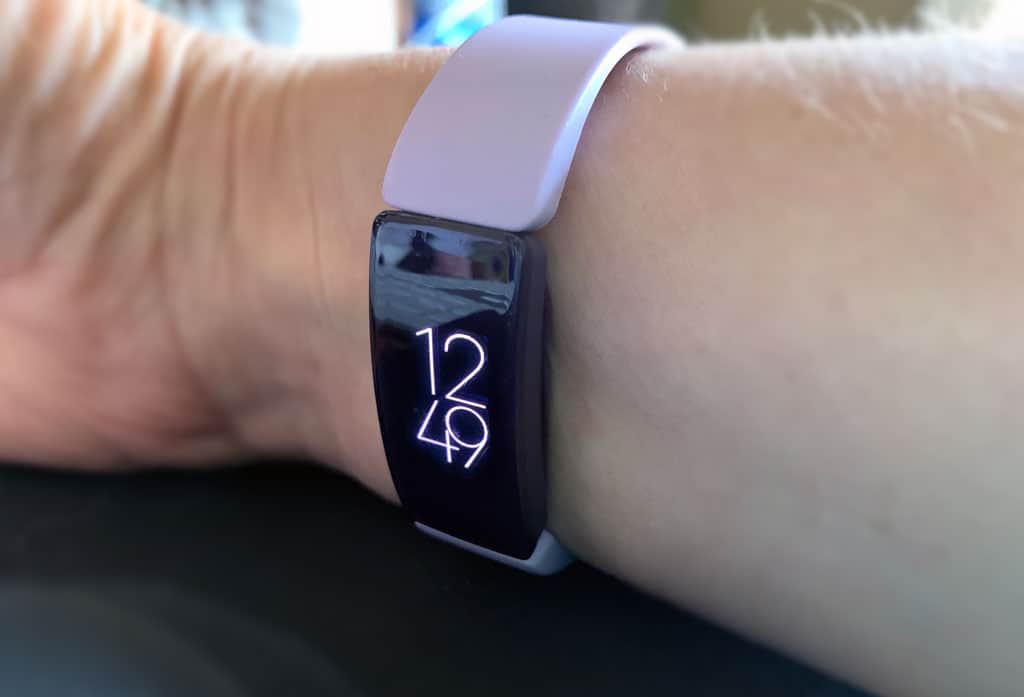
This is especially useful if you have tattoos or have a lot of arm hair (you could also shave your hair but wearing it on the inside is a lot easier!)
You’ll generally get better measurements from your Fitbit, too, for things like heart rate and sleep monitoring.
Are you sweating a lot when working out or engaged in an activity?
When we sweat during workouts, in hot and humid weather, or even naturally during the day, that sweat can get trapped between the Fitbit and our skin.
And if your Fitbit band is tight, it’s difficult for that perspiration to evaporate naturally.

This trapped sweat can then cause your skin to become inflamed, which often leads to redness, discomfort, and, eventually, rashes. Doctors call this moisture-associated skin damage (MASD.)
When that sweat (or another moisture source) gets trapped, your skin starts to soften, then swell (inflammation), and even wrinkle. All of those things make your skin more vulnerable to damage from any present bacteria and the band’s natural friction.
The best remedy is to clean and dry your Fitbit (the device and band) AND your skin after working out or after a sweaty event.
And always make sure you keep your Fitbit slightly loose on your arm to allow air to circulate and naturally evaporate any moisture, so it doesn’t get trapped in the first place!
Are you swimming or showering with it?
Although we can wear out Fitbit continuously throughout the day and even for several days without charging, that doesn’t mean we should!
Don’t shower with your Fitbit!
While many Fitbit bands and Fitbit pebbles are water-resistant, we don’t recommend you shower or bathe with your Fitbit on.
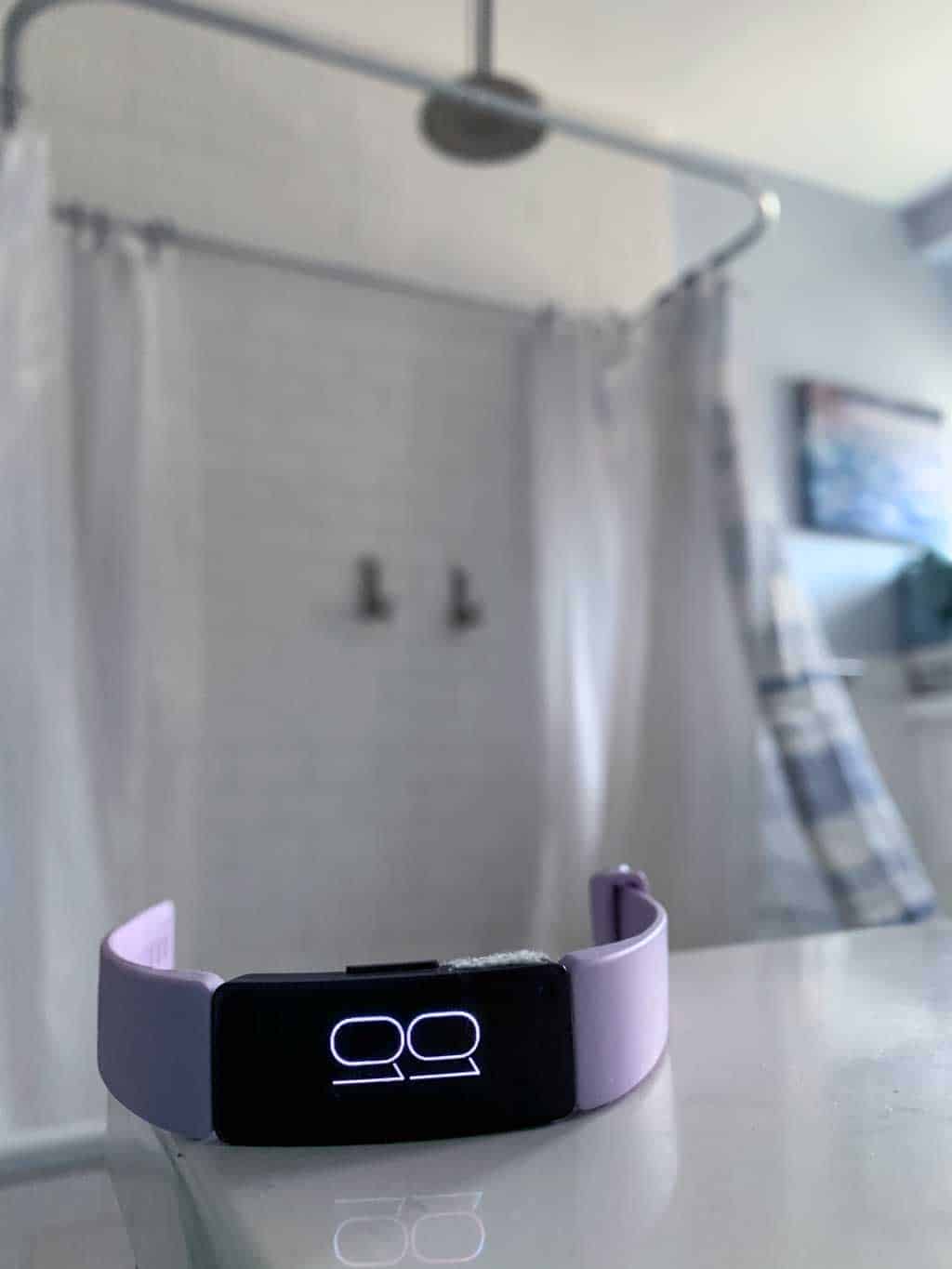
When you shower, your skin loses some natural oils that maintain its moisture barrier. And hot water is even more guilty–it strips away more of your skin’s oily layer.
So if you like hot showers (and who doesn’t), we encourage you to take off your Fitbit!
Showering is the perfect time to charge your Fitbit and give your skin a rest.
After showering, remember to let your skin dry BEFORE placing your Fitbit back on. It doesn’t take long for the skin to dry–usually, about 5-10 minutes, depending on the weather and how steamed up the bathroom is.
That time is the perfect opportunity to moisturize your skin, and if your skin is particularly sensitive to the Fitbits’ bands, add a barrier cream to the area(s) where you wear your Fitbit.
And remember to dry your skin thoroughly before putting the Fitbit back on.
Love swimming? Wear your Fitbit!
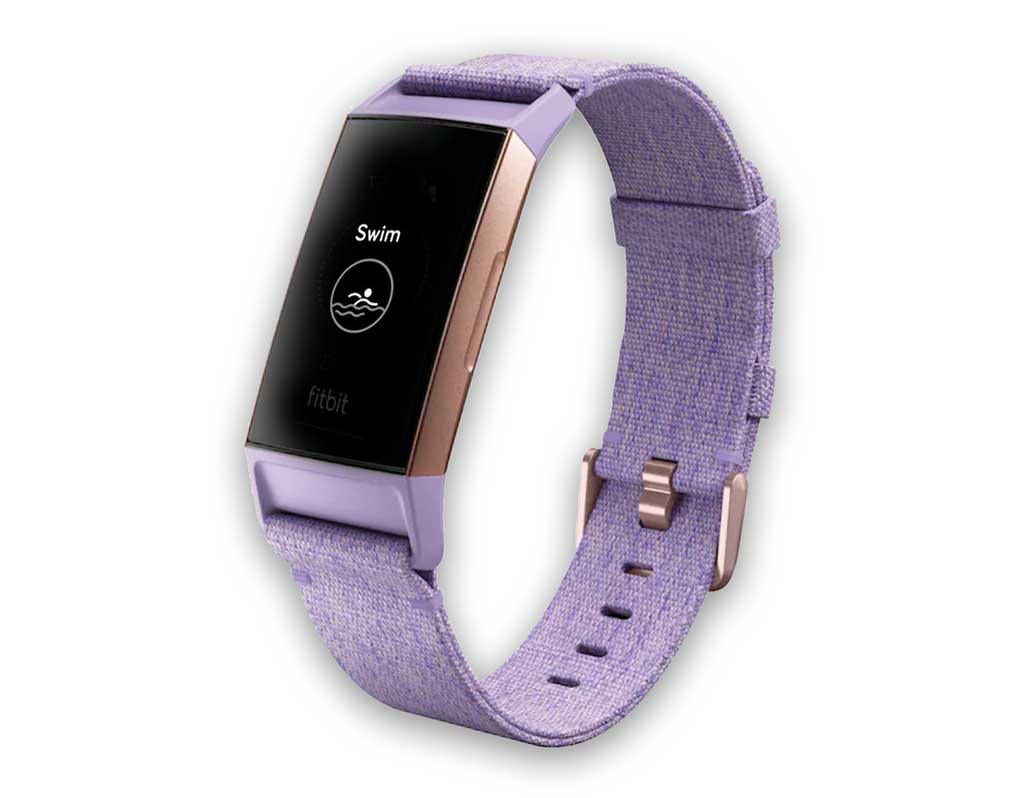
If your Fitbit is a model approved for swimming, wearing your device while swimming is a great way to track that exercise.
If you swim or surf in saltwater, check your model’s user manual to ensure you can swim in salt water and fresh water.
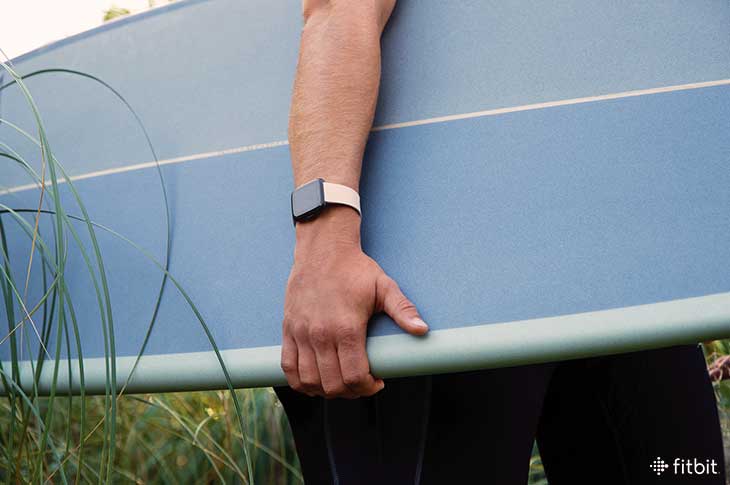
What’s important is to clean and dry your Fitbit and your skin after your swim. And that means taking the device off for a few minutes.
If you’re swimming or surfing in the ocean or a saltwater pool, it’s even more important to rinse all the saltwater with fresh water to prevent salt buildup from your device and skin.
Are you routinely cleaning your Fitbit band and device?
Cleaning your Fitbit band (and the device itself) helps remove any debris, bacteria, allergens, and other gunk that might be irritating your skin and causing problems!
So keep it clean!
That means cleaning your Fitbit band at least once per week if you aren’t working out or engaging in an activity that requires immediate cleaning.
How to clean and disinfect your Fitbit
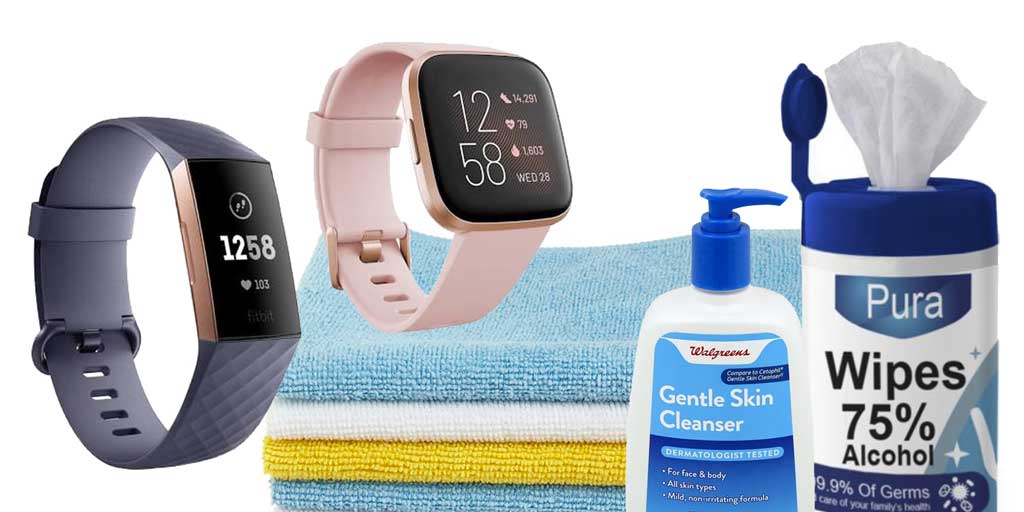
In today’s world, we need to clean and disinfect our Fitbits, including both the device and the band.
It’s best to follow the Centers for Disease Control and Prevention’s infection control recommendations to clean and disinfect your wearable devices.
Follow the motto that the “C” (cleaning) comes before the “D” (disinfection & drying)
- “C” (cleaning) means removing dirt, oil, sweat, and debris using water and a cloth (preferably a microfiber cloth). Fitbit does not recommend using soap to clean your band. Instead, if needed, use a soap-free cleanser on your Fitbit band.
- Find soap-free cleansers in products made for people with sensitive skin or allergies.
- “D” (disinfection & drying) means using at least a 70 percent isopropyl alcohol wipes or Clorox/Lysol Disinfecting Wipes and then letting the band air dry before wearing it again.
- Since rubbing alcohol and disinfecting wipes contain ingredients known to irritate the skin, it’s critical to thoroughly dry your Fitbit band and device before putting it back on!
And yeah, don’t use bleach or submerge your Fitbit into a cleaning agent or disinfectant!
If you use rubbing alcohol to clean the band or the device, ensure the band/device and your skin are dry before putting your Fitbit back on.
Do you have a metal or materials allergy?
If you tried some or all of the steps above and your skin is still reacting, you might have an allergy to the materials or the metals used in the band, buckle, the Fitbit’s casing, or charging contacts.
Specifically, some folks are allergic to nickel or have nickel sensitivity.
Your Fitbit has either anodized aluminum or surgical stainless steel components. Both of those include small amounts of nickel. All Fitbit models meet the European Union’s Nickel Directive for products that come into contact with skin.
Meeting this standard means that most people will not develop skin irritations or allergic reactions to Fitbit products. However, a small subset of users particularly sensitive to nickel may develop reactions, usually contact dermatitis.
What materials and metals are in my Fitbit?
To learn what materials your Fitbit model includes, visit the user manual for your Fitbit model and navigate to the General Info and Specifications section.
There, look for the heading Materials and review for specific information related to your model.
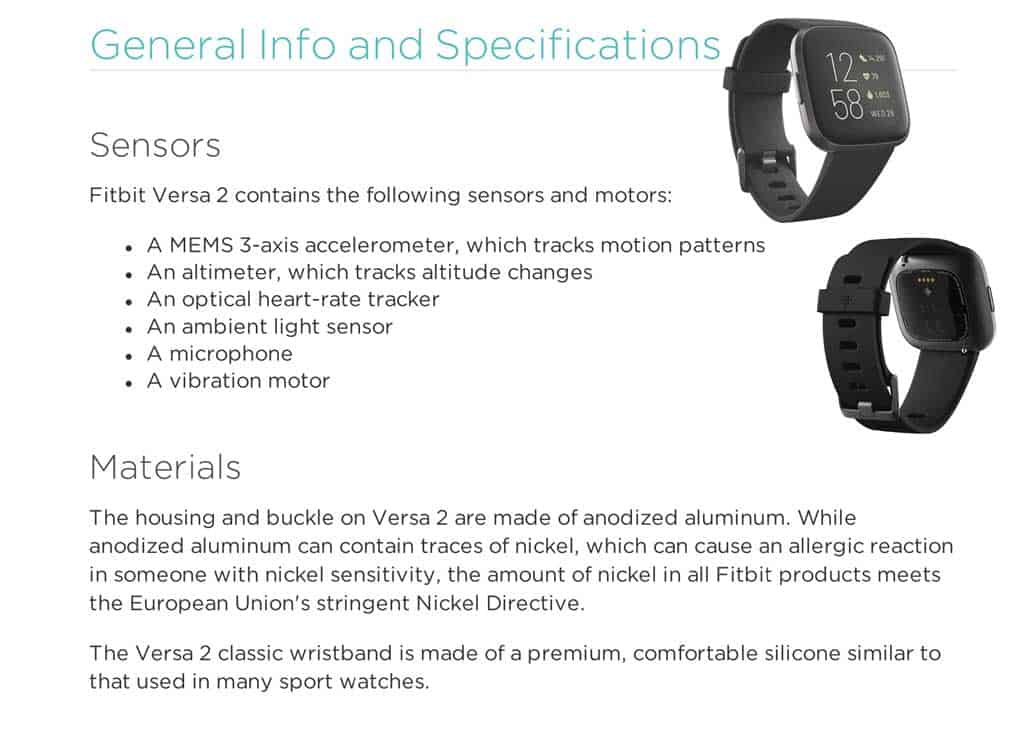
How to prevent material and metal reactions from your Fitbit
If you suspect you have an allergy to the metal components of your Fitbit, it’s likely caused by the metal in the charging contacts reacting to the salts in your sweat and skin.
Very little of your Fitbit’s buckle comes into contact with the skin. So if you narrowed your skin’s reaction to the metals, it’s likely from those gold-colored charging contacts.
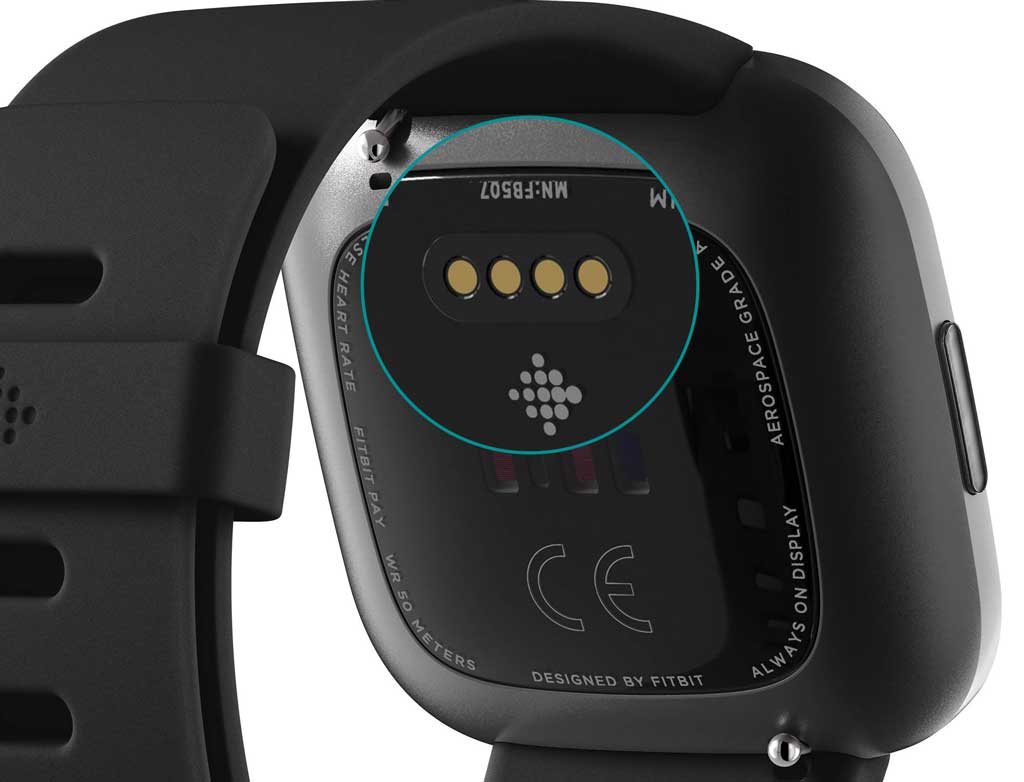
The simple solution is to cover those contacts when wearing it!
However, that is not as convenient as it should be.
Ideally, Fitbit (or third parties) would offer sweat-resistant plugs (that also perform dual duty as anti-dust) for all Fitbit models. However, Fitbit does not produce these items, and most third-party producers only offer them for older model Fitbits like the Surge or Charge (1st generation.)
Cover your Fitbit with tape!
So, instead of a custom plug, the next best option is to manually cover the charging contacts with a small piece of tape.
Some folks use plain old invisible tape, while others recommend microporous hypoallergenic paper, surgical cloth, fabric, or silicone tape. Even using a small piece of a band-aid seems to do the trick!
Make sure you cover only the charging pins, not the other sensors!
You also want to wrap it around the device’s sides to prevent it from dislodging when moving.
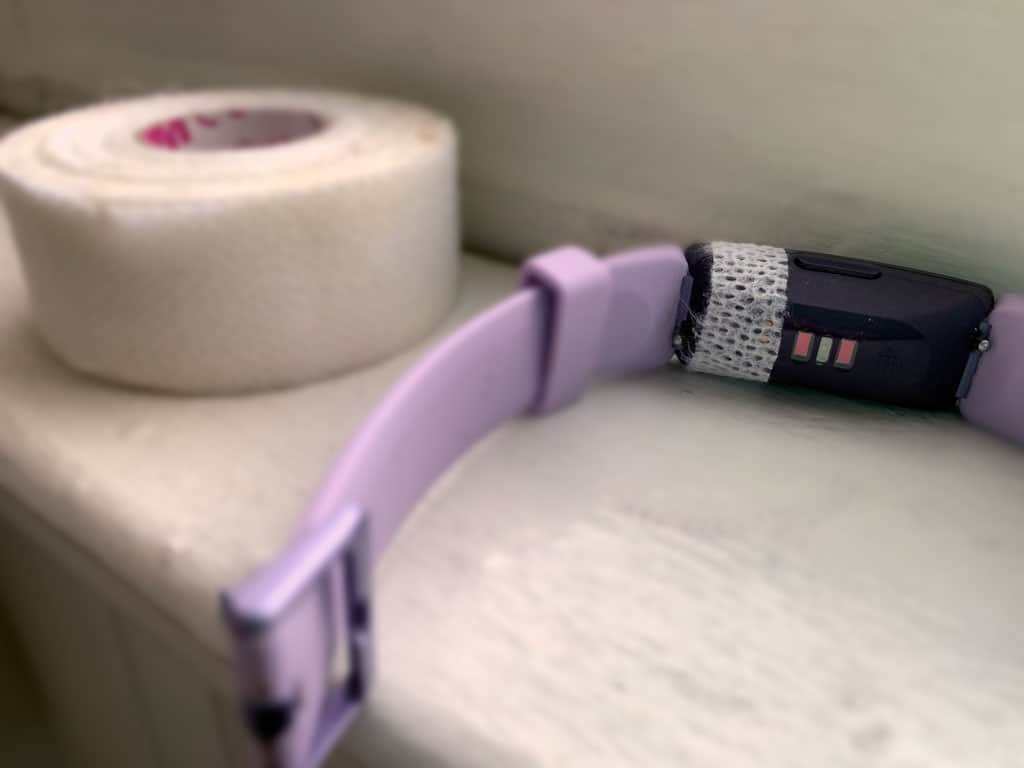
The downside is you likely need to change this cover routinely–sometimes once per day or after removing the tape cover for charging.
When all else fails, return it!
If you continue to experience rashes, allergies, or other skin irritations from your Fitbit and cannot find a remedy, we recommend returning it. When you buy from Fitbit, they offer a 45-day AND no-questions-asked return policy.
If you purchased your Fitbit from any third-party vendor (like Amazon), check their return policies–they often match or beat Fitbit!
If your Fitbit is not eligible for a return, reach out to Fitbit’s customer service to learn about options.

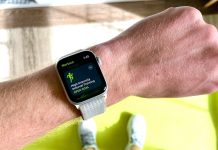
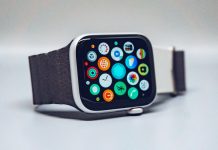
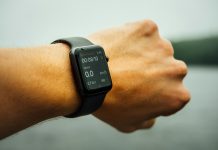



I didn’t have a problem for years but then wore the watch under a work glove in the heat and now I constantly get a reaction from the back of the fitbit watch.
How about just making the woven bands more available for all the models? Or how about using another material you can sweat on especially since we are expected to wear them during exercise and sleep? This is ridiculous
they use a rubber accelerator powder in the factory on the basic bands. I was allergic to my Charge 3 and my Versa 2 bands. Having to buy random ones that ACTUALLY FIT and don’t break me out online is dicey.
If you’re allergic to latex or suspect it, the Fitbit bands will sadly reveal it.
Yet my Flex 2 band didn’t have this problem.
Unfortunately for me, with the nickel on the watch, the second I put it on my wrist, I feel my skin burning. The same happens when I put a white gold wedding ring on.
For that reason, I’m wearing a silicone wedding band and I’m reaching out to Fitbit to see what they can do for me.
None should be required to do any of this just to wear a watch.
The problem is that the material of the watchband is not fit for human use. I’ve never had a problem with metal, leather, or even plastic bands on other watches.
Bluetooth, GPS and Wi-fi connections on fitness trackers and smartwatches all function by emitting and receiving radio frequencies (which have electromagnetic properties) which travel through the dermis (skin) and tissue and bone. Electromagnetic frequencies are all the electrical frequencies carried through the air (airwaves was the term used in the past for for radio and tv broadcasts carried through the air).
This is why all cellular phones come with manuals that state their SAR value that dictates how much distance to keep the phone from the skin to avoid thermal heating (heat burns). The SAR value is based on how close to the head an adult male can keep the phone during a 6 minute call prior to thermal heating of the surface skin. As a result all cellular phones must be kept several millimeters away from the skin. That is for a 6 minute call. A fitness tracker/smart watch is kept directly and snugly against skin 24/7 usually, and many people keep these devices connected to their smart phones via Bluetooth and/or GPS and/or Wi-fi.
It is surprising that many don’t make the connection that the direct physical contact would cause the same issues that they are informed of (if they read their phone manual) by the same companies (Samsung, Apple, etc.) to avoid on their cell phone products for the same reason. My recommendation is putting the fitness tracker or smartwatch into flight mode and/or turning off all wireless connectivity except for when absolutely necessary for GPS-required fitness activity recording (and wearing it with a clip a few millimeters off the body and above clothing if heart-rate and oxygen data is not necessary and only distance and altitude data is sought), and for syncing data. Removing the fitness tracker/smart watch for syncing would be recommended.
Based on my research and testing of various fitness trackers and smart watches, Samsung and Polar smartwatches offer the flight mode function which is the best protection against EMF-based burns. Garmin offers turning off Bluetooth on their fitness tracking smart watches (possibly also turning off flight mode on their GPS-enabled watches) which will do the job too. Fitbits sadly are designed without the option to turn off connectivity and the Fitbit community has requested they be designed with this option since 2010 (based on their forum boards) but Fitbit manufacturer refuses to do so for the past 11 years and shows no plans to do so in the future, so it’s the worst offender for burns and rashes.
Samsung, Polar and Garmin offer very comprehensive and interesting companion apps that meet and exceed the data offered by Fitbit, so these could be interesting options if one is using a Fitbit device mainly for the companion app data and breakdowns. Wear OS was not tested as part of this study, so fitness tracking smart watches using Wear OS and its health ecosystem of apps may have potential as well.
For those who are electro-hypersensitive (we all are electrosensitive, all brain and body cells communicate through minute electrical signals which is what we measure using EKGs and EEGs; death = no electrical activity), or those who become hypersensitized due to the constant exposure to radiofrequencies in such close proximity to the body, the only option is a non-Bluetooth or unconnected smart watch. These don’t provide anywhere near the health data of heart monitor-enabled fitness trackers/smart watches, but will provide data on steps, distance, calories and sleep hours, plus some alarms/reminders, the time, and some water resistance (some state upto 5ATM for swimming but I believe (based on consumer reviews of breakdowns) that it’s safer to consider these safe for dishwashing and possibly showering).
As a beside, how external EMFs affect cell electrical activity is completely unstudied, or at least unpublished if it’s already been studied by the telecommunications industry. One would think that studies demonstrating no influence of external EMFs on internal cell activity would be published by telecommunications and related industries given the mounting pressure against EMF proliferation. Given that human bodies are excellent electrical conductors (seen in applications of defibrillators, etc.), it would be very interesting to see the results of studies on external EMFs on internal cell activity (brain and body) conducted by scientists external to the telecommunications and other stakeholder industries.
I have not yet researched the effects of the optical heart-rate monitors or Sp02/V02 detection lights on skin. Obviously, if these lights use the same ultraviolet wavelengths that are involved in burns (the same wavelengths as those that give us sunburns), then very regular to constant (when in continuous heart-rate measurement mode) skin exposure directly under these lights would be a natural cause for UV-based burns (as opposed to RF thermal exposure-based burns).
Those with lighter skin could be advised to wear sunscreen underneath the fitness tracker/smart watch, however, sunscreen ingredients (water, oils, chemicals, minerals) have not been tested for safety when interacting with any metals, plastics, or radiofrequency sources directly against the skin. So they could cause or aggravate issues for the skin, or for the fitness tracker/smart watch. What we do know is that blocking the visual contact of the optical devices does negatively impact the readings of heart rate, blood oxygen, respiration rate, etc. and could potentially (with a lot of sunscreen or liquid buildup) cause electrical impediments for the charging contacts when they are in contact with electricity while being charged, so companies recommend keeping the skin and fitness tracker/smart watch device back surface clean.
Keep in mind that the fitness tracker/smart watch manufacturers never address EMF burn/allergy or optical UV burn/allergy causes and always put the responsibility on the consumer for irritations (e.g. not keeping the back of the tracker/watch clean, accumulation of oils and sweat, pre-existing conditions, etc.).
The best thing is to inform oneself and only allow the exposures that are absolutely necessary by tweaking the settings and keeping in mind one’s health conditions that could be affected by EMFs (e.g. attentional issues, sleep problems, skin rash triggering when in high EMF environments) and UV light (skin protection needs based on Fitzpatrick skin type, pre-existing conditions or tendencies such as skin allergies or rashes that could be easily triggered or aggravated by EMF or UV).
Keep in mind also, that nickel sensitivity is very high in North America (around 20% of the population in some test studies), so fitness tracker/smart watch backs and bands need to be manufactured with none of the most common skin irritants/allergens (i.e. nickel, brass, copper). As with high quality jewelry, watches and health devices worn for the entire day, consumers can demand stainless steel, surgical steel or gold-plated backs (given the cost of most smart watches, gold plating won’t actually add much as the watch sales profit margins are already quite high).
Nylon and traditional leather seem to be the least frequent offenders and Bisphenol-free and phthalate-free silicones should theoretically also be reaction-free, as long as the frequent rubbing against the skin and skin acidity (which isn’t high compared to acids that actually break down compounds) doesn’t have any way of interacting with any of the band components.
Hopefully in the future, consumers will be more informed and demand skin-contact level devices with lower to zero EMF output, with options to control the frequency of connectivity (on Bluetooth, Wi-fi and GPS), with more intelligent algorithms for the devices (using greater user inputs if necessary) that require fewer optical sampling data points to reduce the triggering of rashes and UV burns, and with allergen-free watch backs and bands.